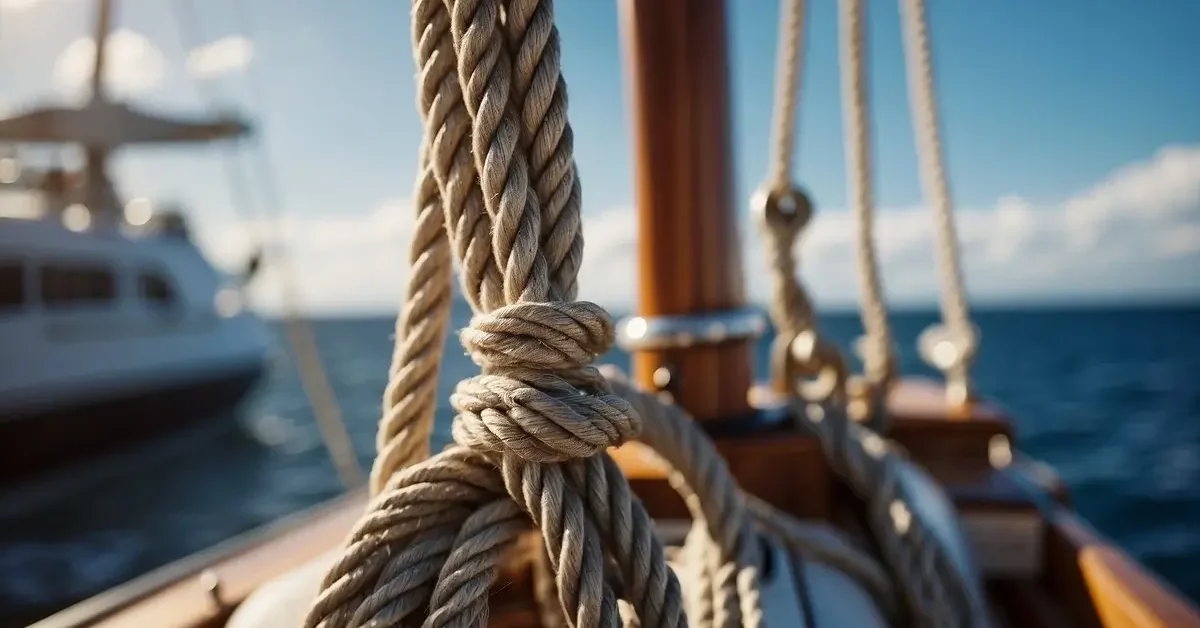Sail Boat rigging is essential to the anatomy of our beloved vessels, forming the backbone that keeps our sails aloft, translating wind into motion. As we explore the complexities of sail boat rigging, we immerse ourselves in a world where every line and knot plays a pivotal role in performance. It’s a thrilling dance of cables, ropes, and pulleys that begs to be mastered by any sailor looking to harness the power of the wind.
Understanding the difference between standing and running rigging is our first step to becoming proficient sailors. The standing rigging, composed of steel cables, secures the Mast in place, while the running rigging involves the lines we actively adjust to control the sails. Both are critical for the sailboat’s operation and getting to know them is as exciting as catching a solid gust on an open sea and feeling the surge of our sailboat responding eagerly beneath us.
Essentials of Sail Boat Rigging
Sail Boat rigging encompasses the systems of ropes and cables that are vital for controlling and stabilizing the sails and masts. We’ll dive into the standing and running rigging world to understand their indispensable roles.
The Anatomy of Standing Rigging
Standing rigging comprises all of the fixed lines that stabilize the Mast. Key components include:
- Mast: The vertical pole that is the centerpiece of the rig.
- Forestay: A crucial tensioned cable at the front that holds the Mast upright.
Here’s a simple breakdown:
| Component | Function |
| The Mast | It supports the sail and transfers wind force to the boat. |
| Forestay | It keeps the Mast from falling backward. |
| Shrouds & Stays | Lateral support that prevents the Mast from swaying side to side. |
The Role of Running Rigging
Unlike static standing rigging, running rigging involves the lines we actively adjust. We use these to trim sails and control their angle relative to the wind. Important elements include:
- Halyards: Ropes used to raise and lower the sails.
- Sheets: Lines that adjust the angle of the sails to the wind.
These components work together to set and change sails efficiently to match the sea and wind conditions. We harness the wind’s power to its fullest potential through correct use, making our sail boat glide effortlessly across the water’s surface.
Rigging Types and Their Functions

The proper rig for a sail boat is crucial for its performance and handling. Each type of rigging offers unique benefits and is designed to suit different sailing environments.
Sloop, Cutter, and Ketch Rigs
Sloop rags are the most common type of rigging found on modern sail boats. They feature a single mast with one mainsail and one headsail, offering simplicity and efficiency. An example of a sloop rig’s simplicity and effectiveness is its widespread use in racing and cruising.
Cutter Rigs add a second headsail, a staysail, to the sloop setup. This additional sail can be particularly advantageous when sailing in heavy weather, providing more options for sail reduction and balance.
Ketch Rigs have two masts, with the Mizzen mast opposite the main. This setup offers a different balance and the advantage of multiple sail combinations, which can be crucial for handling in varying conditions. The ketch rig is often favored for its ability to maintain steering balance and reduced loads on individual sails.
Advanced Rigs: Schooner, Yawl, and Catboat
Schooners carry at least two masts, with the aft mast taller or equal in height to the forward one. Schooners are admired for their majestic appearance and once dominated the American coasts as cargo carriers, courtesy of their powerful gaff rigs.
Yawls resemble ketches but have smaller mizzen masts positioned closer to the stern. Yawls are not just about aesthetics; their rig can offer better windward performance and greater flexibility in trimming.
A single mast characterizes catboats placed far forward and traditionally carrying a cat rig, often associated with simplicity and ease of handling. They boast a broad beam and a shallow draft, making them ideal for coastal cruising.
Maintenance and Performance Tuning

Properly maintaining and tuning the rigging of our sail boat is crucial not only for performance but also for our safety at sea. By paying close attention to the intricate details of our rig’s condition and making precise adjustments, we can extend the lifespan of our equipment and enhance our sailing experience. Let’s dive into the two critical areas that should always be noticed.
Inspecting and Caring for Your Rigging
Before we set sail, a thorough inspection of our stainless steel wire rigging is a must. We examine lifelines, toggles, and turnbuckles for wear, corrosion, or fatigue signs. Stainless steel wires should be free from fraying, and all hardware should be firmly secured. Here’s a quick checklist:
- Lifelines: Check for tension and integrity.
- Toggles: Look for signs of uneven wear or distortion.
- Stainless Steel Wire: Examine for broken strands or corrosion.
- Turnbuckles: Ensure they are lubricated, and the pins are secure.
Regular maintenance, such as cleaning and lubricating stainless steel fittings, will prevent premature wear and ensure reliability. This is especially vital for offshore voyages where the demand for our equipment is even greater.
Tuning for Optimal Sail Performance
Regarding performance tuning, precise adjustments can significantly improve handling and speed. We focus on shrouds and stay tense to maintain an optimal mast bend and sail shape. Proper tuning can be done by following these steps:
- Baseline Setting: Set the Mast to a neutral position with uniform tension.
- Fine-tuning: Adjust the shrouds and stay incrementally while monitoring the sail shape and performance.
- Assess and Adjust: Make further adjustments based on our sailing conditions and performance goals.
Using calibrated tools to measure tension and referencing manufacturer guidelines for our specific rig setup can lead to the most accurate tuning. Regular checks and adjustments during varying conditions will help us achieve and maintain peak sail performance.
Upgrades and Replacement Considerations

When considering upgrades or replacements to your sail boat rigging, we’re delving into a realm where meticulous choices equate to enhanced performance and safety. Let’s explore the best practices for selecting rigging materials and understanding the associated costs and lifespans.
Selecting Rigging Materials
Stainless steel is the quintessential choice for rigging materials due to its resilience and corrosion resistance. When choosing your rigging components, think about shrouds, turnbuckles, and lifelines. Remember, the rigging shop you pick can offer valuable advice on the most suitable hardware and upgrades for your sail boat.
Understanding Sail Boat Rigging Costs and Lifespan
The costs may feel daunting at first glance, but investing in quality rigging pays off. Here’s a breakdown for a more precise understanding:
- Shrouds and turnbuckles typically have a lifespan that warrants a replacement every 10-15 years.
- Lifelines require frequent check-ups, and costs vary widely based on material and complexity.
Anticipating these expenses as part of our vessel’s maintenance will ensure we enjoy our time on the water with peace of mind.
Our Opinion on Sail Boat Rigging

We believe sailboat rigging is essential for the vessel’s maneuverability and overall functionality. Mastery of sailboat rigging can significantly enhance a sailor’s experience, providing safety and efficiency. It’s a skill set that mariners must constantly refine, as it directly impacts the boat’s response in various conditions.
We advocate for rigorous training and regular rig inspections to uphold seamanship standards. Proper knowledge and handling of both standing and running rigging are essential for a smooth sailing experience.
FAQ – Sail Boat Rigging

Sail Boat rigging is an essential aspect of sailing, involving all the ropes, wires, and lines that support a sailboat’s masts, sails, and maneuverability. Understanding how to rig a sailboat properly can enhance performance, safety, and the overall sailing experience. To dive deeper into Sail Boat Anatomy, check out our article about its understanding here.
This FAQ section aims to answer common questions about sail boat rigging, from the basics of setup to the intricacies of maintenance and adjustment.
How long does rigging last on a sail boat?
Replacement Cycle
Wire standing rigging on an offshore cruising boat should be replaced every 10 years or 30,000 miles, whichever comes first. The time requirement is because the wire is more prone to corrosion than the rod.
What is standard rigging on a sailboat?
Standing rigging comprises the fixed lines, wires, or rods that support each mast or bowsprit on a sailing vessel and reinforce those spars against wind loads transferred from the sails.
How tight should sail boat rigging be?
Rigging should always be as loose as possible and still keep the rig in the column and the right prebend. Just cranking down on the rigging more and more will damage the boat.
Share Your Sea Stories about sail boat rigging Below and dive into the sea of discussions by sharing your own sea stories, anecdotes, or questions in the comments below. The water’s fine, join us!









